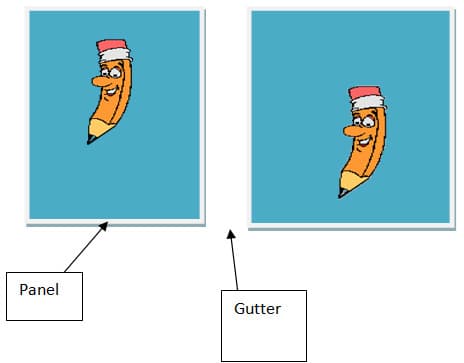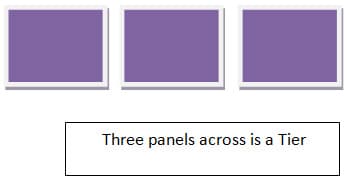Comics and Graphic Novel Vocabulary
While reading, Understanding Comics by Scott McCloud I was surprised and intrigued at how much thought and work actually goes into making a comic book. I also find myself thinking how interesting this will be to my students, especially by boys who are so reluctant to read or write.
The panel is just the line around the individual comic. It is just a border, like making a bold box around text box. This is the beginning of your comic strip. Panels come in all shapes and sizes. You just need to make it easy for the readers so they don't get lost in knowing what panel to read next.
The space between the panels is called the gutter. This is a very important part of a graphic novel or comic book.
"Despite its unceremonious title, the gutter plays host to much of the magic and mystery that are at the very heart of comics!" 11

The width of the gutter stands for space or time. The wider the gutter space the more time has elapsed between what has happened in the first panel to the second panel. The thinner gutter would mean that it is happening fast, like running.
"Space does for comics what time does for film!"12
Comics are usually written in tiers, a tier is a single row of panels. A tier is typically found straight across the sage. Each row across is another tier.

Closure is when we use what we already know to make predictions about something. For instance, If you see the side of a Pepsi™ bottle, even thought you can't see the whole bottle your brain tells what it is by using your background knowledge.
Clarity is making your comic easy to follow and understand by the reader. There are five things you must think about clarity when you are making your comic; Choice of moment, choice of frame, choice of image, choice of words, and choice of flow. These are not done in any certain order but you need to think about each one while making your comics.
There are three kinds of sounds in comics, word balloons, captions and sounds effects. There are also different kinds of word balloons that mean different things. If a word balloon has a jagged edge it means the word is being shouted. If it has ice cycles hanging from the balloon it should be read in an icy tone. Word Balloons that have bubbles means it was not spoken but thought. If words are very tiny it means it is whispered. Sound effects do not have balloons and use onomatopoeia. (sound like the word) Captions are usually not in the frame and are words spoken by the narrator.
A splash is a one page comic strip and a spread is more than one page.
There are six steps in making a comic: Idea or purpose, form, idiom, structure, craft, and surface. All of them are just as important but do not need to be done in any certain order. Idea/ purpose: Why are you writing the comic? Form: What are you making? A drawing, comic book, a flip book? What are you using? Crayons, colored pencils, ink? Idiom: What are you writing about? What are you trying to accomplish? Structure: How are you going to arrange your writing? Are all of your panels going to have words? Is it going to be in black and white or color? Craft: The actual writing and art. Surface: The actual comic and what people notice first when they pick it up.13
There are five areas of making comics that will your readers understand what you are saying or just leave them confused. In addition, intensity will also bring understanding and clarity to your comics.
Choice of moment is deciding what you want in your comic and what you want to leave out. If you put too much information in the comic the reader will get confused or bored but you want to make sure you have enough in the frame so the reader understands what you are trying to get across to them. An example might be, If you draw a dog running and the dog stops to pick up a bone, then he moves the bone to another location and buries it, then he sees his friend and runs and jumps on the friend giving them kisses. The plot has nothing to do with the bone, it is not needed and just confuses the reader.
"Obsessing to much over such details is a classic beginner's mistake".14
Choice of frame is deciding the shape and how far apart you want each frame. Remember the space between the frames (gutter) shows time in between the frames. If your character is running the frames you would them to be closer together and if your character is walking they would be farther apart.
Choice of image is making sure your frame is clear and not cluttered with pictures or words that are not needed. If you are drawing a man building a house you don't need a bunch of flowers and trees in the frame. Make is simple and easy to follow, especially when you first start making your comics.
Choice of word is just like it sounds. Find the right words you need in each frame. Do not put to many words in or it will look cluttered and hard to read.
Choice of flow is making sure it is clear what frame the reader needs to go to next. There is nothing worse than a reader getting lost and confused. They may not want to finish reading your comic.
Intensity
There are some comic book techniques that tell the reader "this frame is special", like visual and depth cues, using diagonals, and even frames without borders.
"Visual techniques which add contrast, dynamism, graphic excitement, or add a sense of urgency to a panel."15 All of these show intensity.
Depth cues makes something look either far away in a frame or can make things seem closer in a frame.
Putting Diagonals in a frame can make something look like it's falling or your character is climbing something like a building.
Making frames without boarders makes things come alive and look like it's jumping off the page.
Making frames different shapes and sizes is another way to bring attention to your comics.
Whatever you do in your comic your overall goal is to make the comic clear so the reader understands your story and make them know you care about what you made. After all, you spent a lot of time of your project, make it count!
Building Characters
There are three areas in building believable characters without losing your readers attention, an inner life, visual distinction, and expressive traits. Everyone knows that each character needs to be unique but think closely before drawing your character. Is your character nice? How can I make them look nice? Is your character rich or poor? What does that look like? If your character that lives in poverty you do not want them wearing fancy clothes or driving an expensive shiny car. If your character is a puppy that lives on the streets he needs to look dingy and not look clean with bows in his hair.
Another important area to think about is you do not want all of your characters to be the same. If you are writing a story about the homeless puppy, everyone in the story does not need to be homeless, in fact if they was it would probably be a really boring story. In the story Guinea Pig Private Eye, all of the characters are not animals, some are people. Not all of the animals talk in the book just the animals trying to solve the mystery. They also made sure to include all kinds of animals you might find in a pet shop and not just cute furry animals. This make the characters more realistic to the reader.
The most important thing about making comic books is to have fun and use your imagination. Chances are if you are having fun writing them, your readers will have fun reading them.

Comments: